|
Last week I ran two games of Longstreet over two days, for two groups of players. The scenario was Blocher’s Knoll, which is on the scenario page here. I had written the original scenario 7 or 8 years ago but updated it for the latest outing, having read a bit more about Gettysburg in recent years. The scenario concerns Ewell’s assault on the Federal right wing just north of Gettysburg on 1 July 1863. Howard’s XI Corps is spread thin, facing north, from where Ewell’s Corps is approaching. Ewell, meanwhile, is marching down two converging roads, one of which points directly behind the Federal right flank. It is an opportunity to dislodge and roll up XI Corps. Game 1: “I was winning the battle at 4, but lost it by 5!” The first game pitted Dan and Harry’s Confederates against Spencer’s Federals. Spencer had three brigades of mainly cautious veterans (Pennsylvania Dutch, still smarting from their rough handling at Chancellorville), with Barlow’s division in front and Krzyżanowski in the second line. Dan led Early’s division on the left, heading for Spencer’s hanging right flank, while Harry kept Spencers attention from the front with Dole’s brigade. Spencer, who has a history of aggressive play, set out to spoil Dan’s attack with one of his own and to put pressure on Harry. Rather as one might expect, the cautious Pennsylvania regiments were just not suited for aggressive charges and bounced off the secessionists wherever they met them. However, a cautious veteran is still a veteran and they fought much better in defence. Losses mounted on both sides but the Confederate left hook developed well and when Blocher’s Knoll fell to Early, Spencer seemed perilously close to defeat. Spencer then got a break that totally changed the picture. In his enthusiasm to outflank the Federal position, Dan sent a regiment in march column over the bridge across Rock Creek, right under Federal noses. Spencer hit the march column with a big, seasoned regiment and almost wiped it out. In the victory step of his turn, he rolled high and the game was over. Longstreet’s victory conditions are a feature of the rules that I really like. They permit scenarios between unbalanced forces where the final issue may not be in doubt, but the weaker force can still win the game. Spencer had fewer numbers and poorer quality troops but he deservedly snatched victory from defeat when he punished Dan’s rashness. We agreed that had we continued playing, the Federals would soon have been rolled up by superior Secessionist numbers. It was a shame for Dan and Harry, who barely put a foot wrong until the march column/bridge incident. But somebody had to lose and they did so with good grace. Game 2: “More Troops? Where would you have me find more troops?”
Game two was a two player clash between Chris’s Federals and Ian’s Confederates. Ian attacked Chris’s left with Dole’s brigade, while he marched Early’s division down the other flank, deploying his artillery to cover Blocher’s Knoll from the east while Gordon’s brigade attacked from the north east. I did think this would be a game-winning attack and the rebel guns did some serious damage to the defenders on the knoll. However, three factors conspired against a Secessionist win: Chris sent a regiment over Rock Creek to fire into the flank of the rebel artillery, which didn’t so much damage as distract it from it’s main purpose; Gordon’s Brigade took too many losses to carry Blocher’s Knoll on its own; and Dole’s brigade got itself annihilated in an unequal struggle against the stronger Federal Left. While losses were high on both sides, Ian’s crossed the line first and Chris took the win. So the Federals won again. As with the first refight, it was inevitable that the next assault would have succeeded, but in game terms, the initial attack had been too costly for the rebels. Ian observed that at game’s end he had Avery’s and Hays’ brigades still fresh, drawn up behind the artillery, while poor old Gordon had marched up Blocher’s Knoll on his own. Ian also reflected that he need not have pressed the assault by Dole against the Federal Left: he could have pinned Chris in place by standing off, ready to advance if the Federals depleted their left to support the right. As ever, both games were great fun (for me, at least!). I am glad to have dipped back into Longstreet and hope to have made some converts to these subtle and engaging rules.
0 Comments
I have been asked if I would upload the player briefings that we used for the Shenandoah Campaign that we played twice during the Spring and summer lockdown. I have added these at American Civil War scenarios.
In November we started another campaign, based on the activities of a unit of French Maquis in the run-up to D Day. As we are still unable to meet up, I tried to make this more of a narrative story, without the tabletop encounters that feature in most wargame campaigns. Inspiration for the storylines came from the excellent book, "Forgotten Voices of the Secret War". The spirit of the game is intended to be a little tongue in cheek and neither side is allowed to contemplate atrocities. Not as silly as the UK TV comedy 'Allo, 'Allo but not far off. The campaign started well, with a clever German player intercepting an arms drop in the first phase. One maquis player kidnapped a collaborationist mayor's dog (Fritzy), which became the new mascot of his group. A group of escaped Allied airmen was spirited out of the region under the noses of the Germans and a radio interception unit was shot up in an ambush. After the chance discovery of an arms cache, the Germans laid a trap which wiped out a maquis section. So far, so satisfying. Unfortunately real life then intervened and I had to suspend the campaign, as my father had fallen seriously ill. The players were very understanding. Sadly, my dad passed away shortly before Christmas and there is a lot of administration associated with his estate. I am not sure when I will have the head space to get back to the campaign and when I do, the players may decide that the moment has passed. I would quite understand. But the exercise has been fun and if this game is abandoned, I'd like to try again in a few months. The map and campaign rules are at WW2 Maquis campaign. When the lockdown began, a few jokes did the rounds that wargamers would barely notice the difference since we already spend so much time alone with our hobby. Of course, the same joke has been applied to online gaming, model railways, stamp collecting and other indoor pass times. And to some extent, I do think those of us with hobbies like these might have had some advantages compared to people whose leisure involves, say, team sports or ballroom dancing. But the past few months have brought home to me that interacting with other gamers is central both to my enjoyment of wargaming and to my motivation. It has been a challenge to make up for the absence of face to face gaming.
Although we haven’t met to play since mid-March, I have found our little wargaming WhatsApp group to be a source of entertainment and solace over the past several months. We range in age from mid 20s to 60 and have diverse interests but I greatly enjoy our chats and following other gamers’ projects. Our first attempt to fill the gaming void was a play-by-email ACW campaign. Players supplied their instructions each turn and I resolved the moves on a master map. I played out larger battles solo, using plans submitted by the players, and worked out lesser encounters with a simple combat results table combined with some free kriegspiel. The most fun for me was inventing a bit of incidental narrative, such as the nighttime escapade of a federal cavalry unit passing through rebel lines, aided by a local school mistress who supported the union cause. This incident had very little impact on the big picture but added some flavour to my next report to General Frémont. I ran the ACW campaign with two groups of players and I think it went quite well. I hope the players enjoyed it too: I was given a rather fine bottle of Black Dog gin by one group after their campaign ended. I wish I could have played more socially distanced games once the lockdown eased but have only managed one, with my son Nick, which was a knockabout ‘Middlehammer’ game between Orcs and Empire. I suspect our choice of an old Games Workshop System was influenced in part by the desire to play a familiar game from happier days. Or is that a bit deep I wonder? For the rest of my hobby time I’ve been rebasing old figures, painting models that I’ve had for years and writing scenarios for when face to face gaming comes back. I’ve also ordered my first 15mm Napoleonics for at least twenty years, mostly in the form of gun limbers but also an entirely new army: I’ve always loved Bavarian uniforms and am delighted to have added them to my collection. This afternoon new measures were announced by Boris Johnson to tackle the resurgence of Covid cases in the UK. Maybe it’s time I started looking at another email campaign... Our second Valley Campaign of lockdown ended today, with victory for Stonewall Jackson and Baldy Ewell. This campaign lasted for ten turns (taking about that number of weeks) and ended with a decisive victory for the rebels. I’m glad to report that all four players put their all into the campaign, right up to the final turn. Below, I am recording the Richmond Times report that went to the players today. Afterwards, I have supplied a post campaign analysis, again shared with the players. Gentlemen This is a different form of report from previously as you are all receiving the same document. The campaign has ended with a victory for the Confederacy. Jackson and Ewell are in possession of Winchester. Banks is at Charlestown and Frémont at Martinburg, excepting a force at Wardensville. The Federals have lost a great many men and materiel and are not in a position to continue the fight for now. The last turn proved decisive. I pass on the following report, some of it eye witness, by Monty Breeches, a correspondent of the Richmond Times, travelling with General Jackson. “The past few days have seen a dramatic series of events, the consequence of which has seen the retirement of Union forces towards the Potomac. It began a while back with a reconnaissance ordered by General Jackson, to explore the passes into the valley from the Allegheny mountains. His cavalry reported that the road to Winchester across Cacopon River Crossing had been left unguarded. Jackson responded immediately, summoning all available troops to follow this route into the heart of Federal territory. The Federal commanders, Frémont and Banks, reacted to this movement by pulling back their forces from further up* the Valley, but Jackson got the drop on his opponents and, after some struggle, took Winchester from Banks, in so doing dividing the latter’s Command. Meanwhile General Ewell followed the Federals northwards, keeping in close touch with their outposts. The final stage in the campaign began with Jackson established in Winchester with almost his entire command; Banks divided between Charlestown and Middleton; Frémont between Strasburg and Wardensville; and Ewell between Front Royal and Mount Jackson. Banks and Frémont agreed that their top priority must be to regain Winchester and so reopen communications with Harper’s Ferry. To do this, Frémont would recall his forces from Wardensville and march northwards down* the Valley Pike. Banks would wait for his approach and then the two would attack Winchester simultaneously from Kernstown, Middleton and Charlestown. This plan, however, depended for success upon the inactivity, or at least sluggishness, of General Ewell. A dangerous calculation indeed! For General Ewell, aware also that a crucial challenge had arrived, chose this moment to unleash a bold assault on Strasburg from the South and East. In one of those occasions when bad luck bites the bottom of the bold, Frémont, in his haste to move north, marched out of the entrenchments at Strasburg before his troops in Wardensville reached the town, leaving the defences unoccupied. At just this moment, Ewell’s cavalry, reinforced by half of Jackson’s cavalry, arrived in the town, followed closely by hard marching infantry. Frémont, who by chance was riding through en route from Wardensville, ordered his accompanying cavalry to restabilise the situation while his infantry forged ahead to Winchester. It was a brave decision not to recall any infantry from the march. Alas for Frémont, his cavalry although it fought bravely, could not stem the confederate tide. Ewell’s troopers smashed through the federal horse. Ewell detailed some troops to hold Strasburg against the Wardensville road and, fully aware of the need for haste, spurred his main body onwards down the pike. With Ewell coming up fast behind him, Frémont was forced to turn his forces around or face being taken from behind while on the march. The messy running fight that ensued favoured Ewell, whose cavalry was superior in both numbers and quality. Try as Frémont might to send at least one brigade to attack Winchester, his whole command became embroiled in the battle. Frémont’s men fought stubbornly but by nightfall, his line had ruptured. Frémont himself was wounded and made off northwards with a knot of troopers. Various small bodies of men made their escape in the darkness, but a great many Federals were taken prisoner. Skirting around to the west of Winchester, the remnants of his command began to reassemble at Martinburg. Meanwhile the Federal troops following on from Wardensville were surprised to find their way blocked at Strasburg by Confederates who were themselves now manning the town’s entrenchments. After a half-hearted exploratory attack was repulsed, they retired on Wardensville, guessing that Federal fortunes had taken a dark turn. While Frémont and Ewell fought their running battle between Strasburg and Kernstown, Banks launched his assault on Winchester. However Jackson, well served by his aggressive scouts, had good warning of both advances and met each of them with resolution. The attack from Middleton, led by Banks himself, made initial headway and at one point broke in to the rebel earthworks. It was then thrown out by a counterattack by the Stonewall brigade. Banks was hampered by falling ammunition supplies, having been unable to restock since the first attack on Winchester in the previous turn. Determined not to be cut off from Harper’s Ferry or ground between Jackson and Ewell, Banks was able to retire cross country towards the east, eventually linking up with the rest of his command at Charlestown. His losses in men and materiel, however, were considerable. At the end of this eventful turn, Ewell marched into Winchester to meet Jackson in person for the first time since the start of the campaign. The two men celebrated with a pot of coffee and a tray of grits. (Well, what did you expect? Jackson weren’t no party animal and Ewell could hardly get pissed on his own). Post Campaign Analysis The first moves of the campaign saw the Federals take and hold the central position, while Jackson went West and Ewell held the eastern fringes of the valley. Jackson displayed an admirably focussed maintenance of aim. He set himself the campaign objective of a left hook through the Alleghenies, first to cut Fremont from his supply line and then to get in behind the federal line. All the while, there was scope for the Union to overwhelm one or other rebel wing and for most of the campaign, they were able to bring superior numbers to each confrontation. The transport capacity of the Valley turnpike was also a great help. For much of the game there was the thinnest rebel screen in the centre, which was fortunate not to be overwhelmed. But the rebels evidently calculated, rightly as it turns out, that if Jackson kept pushing northwards, the enemy would have to conform to his movements. Sure enough, the Federals kept a nervous eye to both east and west and were made cautious by the prospect of Jackson or Ewell falling on their flanks. Jackson’s repulse at Strasburg was a surprise blow to the rebel commander, who had not expected both Frémont and Banks to be present in force. After Strasburg, I thought the campaign was about to be won for the Union. The victors even agreed on a march south that would, I am convinced, have ripped the Confederate defences to shreds and at the very least, have brought Jackson tearing back down the valley to protect Staunton. Yet over the course of their exchanges they persuaded themselves that a more cautious advance was preferable, since they feared a threat from Ewell in the East. At the time, the Pike in front of them was weakly defended and there was in fact no threat from the east beyond an aggressive rebel cavalry regiment. Looking back, I think the federal decision to go cautious after Strasburg was the turning point in the campaign. From then on, the initiative passed to and stayed with the Confederates. In the final stage of the campaign, the rebels got into the midst of the Federal position, seizing the central position that had benefited the Federals until then. First Banks and then Frémont had their commands split by enemy action. Moreover, Jackson and Ewell were now close enough to one another to combine their efforts to defeat their enemy. Winners and Placed
I have been awarding VPs to all players throughout the campaign, both for physical achievements (battles won, supply centres captured) and for actions or behaviours that impressed me. The table above is entirely subjective of course, but I added points each turn, based on the outcomes and orders submitted at the time. While the rebels are overall winners, there are areas where every player performed well. In the end, the totals levelled out pretty evenly, with the exception of Jackson, who received extra points for taking one supply source, blocking another supply line and demonstrating a single-minded capacity to keep his eyes on the prize. Of course, he couldn’t have done this without Ewell’s readiness to keep Federal attention in the Valley. Jackson’s tour of the Alleghenies left Ewell constantly facing superior enemy numbers. He was prepared to give ground where the odds looked too dangerous but he was quick to move northwards again when the chance arose. Crucially, in the final stages, he was close enough to the action to act in concert with Jackson and thwart the federal attempt to reopen their supply lines through Winchester. Ewell showed plenty of aggression when it was needed and without him, Jackson would very likely have been ejected from Winchester. Banks and Frémont started the campaign very well, reaching quite far south and causing Ewell in particular some uneasy moments. Throughout the campaign their cooperation was excellent, sharing all information and acting almost as one command. This allowed them to respond to the threat to Strasburg with a nasty surprise for Jackson when he found both Frémont and Banks to be present with large portions of their armies. Their plan and execution of the battle of Strasburg was first rate. For ruses, Frémont showed particular ingenuity. He mined (and blew) bridges; indulged in a bit of Beau Geste posturing behind earthworks, crept a cavalry regiment past a sleeping garrison and hid whole brigades in ambush. Everybody participated with complete focus and exemplary sportsmanship throughout the campaign, accepting bad news with good grace and never questioning the umpire’s reports. This is especially impressive considering that the restrictions of lockdown prevented players from playing out the battles that occurred. If the defeated secretly thought that had they been rolling the dice in person, the outcome could have been different, they did not share such thoughts with me. I hope you enjoyed the campaign. I am very grateful to you all for taking part. My lockdown has certainly been more bearable thanks to you. I hope to meet and perhaps play a face to face game with you before too long. Tim (Note the photos with this post are of figures in my collection but are not ‘action shots’ of the final turn, as I played this out using unphotogenic counters and maps). * I am indebted to George Mangano from Winchester for explaining that troops moving northwards are travelling ‘down’ the valley, and vice versa. It’s always good to get these things right! I have been running a second Shenandoah Valley wargame campaign, this time with four new players, two rebels and two Federals. We are using the map and rules from the first campaign (here) but set later in 1862, with more forces and four separate commanders: Frémont and Banks versus Jackson and Ewell. To cater for four players I made one basic change from the historical situation: Ewell is not subordinated to Jackson. Otherwise the troops are based on those present in the historical campaign. The first five turns have seen various skirmishes and one or two bigger actions that I have resolved with weighted dice rolls, using a board game-style combat results table. But this turn we had our first big battle at which both sides were determined to slog it out, so I played this on the table with instructions from the three players whose characters were on the field. The location is Strasburg, on the Valley Pike, where Jackson, played by John, attacks Frémont (Keith) and Banks (Dave) from the West. Jackson had earlier bundled two federal brigades out of Moorefield and then Wardensville. In response the Federals, who had been moving southwards down the Valley, concentrated on Strasburg ready to protect their main supply line. Rules and figures I used the On to Richmond rules published by the Courier in the 1980s. These rules got me into ACW gaming and although I haven’t played them for several years I had fond memories of them. My usual rules, Longstreet or Pickett’s Charge, were too small scale for the numbers involved while OTR uses brigades as units and a scale of 1” to 50 yards. OTR uses a card-activated sequence of play, stand removal and D10 and D100 dice rolls. Figures were 12mm Kallistra figures on 1” frontage bases, two of which counted as one OTR stand. I created a map using Google Maps and historic maps of Cedar Run and Fishers Hill, the two battles that took place historically, one north and one south of Strasburg. I sent briefings to the players that I won’t post yet as the campaign is still happening. The players sent back their dispositions and plans for the battle. I set up the table on Thursday and played the game the next day. Troops engaged: Federals Frémont Cluseret’s Brigade Schenck’s Brigade Milroy’s Brigade Bohlen’s Brigade 3rd West Virginia Cavalry Two artillery battalions Banks 1/Kimball 2/Kimball 1/Tyler One artillery battalion Confederates Jackson 1/Garnett 2/Garnett 1/Fulkerston 2/Fulkerson Connor’s Brigade Three artillery battalions The Federals deployed Cluseret and Schenck in entrenchments along the railway embankment around Strasburg. These were the brigades that Jackson had previously ejected from Moorefield and Wardensville. Artillery was placed in the fort northeast of the town. Other troops were deployed in hiding, some within Strasburg town and some behind woodland in the northeast corner of the table. 3 West Virginia cavalry deployed to the west of the position on Fishers Hill, the high ground south of Tumblers Run. The federal plan was to hide its strength until the rebels had fully committed to an assault. Jackson started with two large brigades on table: Garnett and Fulkerston, each comprising two formations in OTR, plus an artillery battalion. Connor’s brigade arrived from Wardensville soon after with further artillery. Jackson began his attack against the enemy’s left flank, ignoring the federal centre and right. Frémont’s cavalry, defending Fishers Hill, tried to slow Jackson’s advance. The cavalry successfully held up Garnett, the leading Confederate brigade, while Milroy’s brigade, previously out of sight, formed up behind the railway line to complete the federal defensive line facing west northwest. It’s job done and now under great pressure, the cavalry mounted and retired behind the federal earthworks. To Garnett’s left, Fulkerston’s Confederate Brigade advanced in line on the Federal earthworks. Its first volley so disrupted Cluseret’s brigade that the latter abandoned their position. Fortunately for Frémont, as Fulkerston advanced his left wing had come under fire for the first time from federal artillery in the fort and was forced to pause to regroup. This gave time for Bohlen’s Federal brigade, waiting in reserve, to reoccupy the abandoned earthworks before the rebels could reach them. The right wing of Fulkerston ‘s brigade however managed to close with the federal artillery that was now alone behind the earthworks and overran it. Before more rebels could join Fulkerston’s left, it was counterattacked by Bohlen and Cluseret, who had regrouped and returned to the combat. Fulkerston’s whole Brigade now settled into a firefight with the Federals and declined to advance again. Jackson’s reinforcements, Connor’s brigade, now arrived on the table and started moving towards the right flank. At that point two fresh federal Brigades broke cover from the woods in the north-east and marched hard towards the rebel left rear. Brought to a halt in front of the earthworks and now clearly outnumbered, Jackson redirected Connor to face the advancing federal reinforcements and he recalled the troops assaulting the federal left. Under the cover of Garnet’s Brigade, which had only just become meaningfully engaged in the attack, Jackson successfully extracted his right wing. Two of Frémont’s brigades followed up initially but having fought hard all day, they rested on the field, while the two brigades previously defeated by Jackson remained in the entrenchments before Strasburg. Banks took over the pursuit with Kimball’s Brigade and the 3rd West Virginia cavalry, which had passed through the town and moved north to support Banks. Jackson instructed Connor and his supporting artillery to cover the retreat of the other brigades and while this Brigade was mauled by Banks, it gained time for the rest of the rebel army to get clear. As the battle ended Tyler’s brigade arrived to reinforce Banks from Kernstown. Overall Jacksons army had faced odds of over 2 to1 and was fortunate not to suffer more serious losses. His decision to attack the federal left saved him from a much more serious defeat. Banks, hidden in the north-east woodland, had been ready to take Jackson in the left rear once he had become engaged against Frémont. Once it became clear that Jackson would not come round to the north, Banks left hiding in a dash to cut Jackson’s retreat route.
Banks and Frémont dined in Strasburg that evening, satisfied with their success but a little disappointed that Jackson had not been caught completely in their trap. The Federal battle honours for the engagement went to Milroy’s brigade and to Cluseret who, after first running from the enemy, recovered and then helped repulse them from the union position. In Jackson’s army the most resolute troops were Fulkerston’s brigade which made it into the earthworks despite heavy small arms and artillery fire. Garnett was less impressive, allowing himself to be slowed down by a small but determined Federal cavalry regiment. He nevertheless fought a solid fighting retreat and suffered very few losses from the engagement. Connor fought splendidly against superior numbers but paid for his stubbornness. I now have to roll these results into the outturn report. I very much appreciate the readiness of all four players to devote their minds to this campaign and to allow me to determine their fate on the table. It must be frustrating, especially for the side that comes second! Our ACW campaign has come to a close, with victory for Jackson. The last two turns of our campaign saw Jackson, played by Matt, gaining a significant advantage over Banks’ forces led by Spencer. In the west, Banks’ attempt to outflank the rebels in the valley, which had been so promising after the battle of Franklin, was thwarted when he withdrew a third of the outflanking force just as Jackson was reinforced. The outflanking force was repulsed at the battle of Harrisonburg and then trapped and nearly annihilated between Jackson’s force and General Johnson’s brigades advancing from McDowell. Meanwhile, in the valley, Banks drew in his forces and advanced to Mount Jackson along the Valley Pike, leaving the Luray valley road in the east uncovered. At just this time, Jackson sent two brigades and a strong cavalry reconnaissance through Luray and Front Royal, to find the federal supply line back to Harper’s Ferry exposed. On turn 5 of the campaign, rebel cavalry occupied Strasburg behind the main federal army and captured rear area troops, ammunition and grain supplies. Before he cut the telegraph, Ashby, commander of the 7th Virginia Cavalry, wired the following message to Banks from Strasburg: “From the officer commanding the Confederate garrison of Strasburg to the General commanding, federal forces. Thank you for provisions and ammunition. There is no need to send more as we now have a proficiency of both. Respectfully, Ashby, Lieutenant, 7th Virginia Cavalry.” (I stole this idea from a French bonapartist pamphlet of 1815, in which Napoleon thanks Louis XVIII for the troops he has sent and says he doesn’t need any more). The closing positions of the active game therefore had Banks at Mount Jackson with his supply line cut, and Jackson, reinforced by Ewell, with forces to the south, east and north of the federal army. Banks was still formidable but Spencer decided at this point that he had been outmanoeuvred and conceded to Matt. I played out the following turn myself, presuming Banks would try to escape encirclement while Jackson would attempt to catch him. The only way Banks could get clear was to retreat all the way back to Winchester, while Jackson ended at Kernstown and Middleton. The Federals were back where they had started the campaign, with one very badly mauled division, the other virtually unbloodied and a great many supplies now equipping the rebels. So Banks is still in the valley and will no doubt be ordered to resume hostilities very soon but our small part of the campaign has ended. Post campaign analysis: a game of two halves The campaign divided quite starkly into two phases. Spencer started well, with the idea of getting one division around behind the rebel army from the west, while advancing steadily down the Valley Pike with the other division. At this point Matt seemed to lack a plan, for example, sending a brigade westwards only to recall it the next turn. He very nearly lost this brigade between Spencer’s two divisions. The high water mark for Spencer was the Battle of Franklin, ably generalled by Dan as General Shields. Then it seemed the initiative shifted the other way. Spencer recalled one of Shields’ brigades despite ordering him onwards into the rebel left rear. The recalled brigade spent the rest of the campaign marching through the Alleghenies when it could have been critical in helping Shields to deal with Jackson’s reinforced army at Harrisonburg. At the same time, the other federal division stopped its southward march and dug in at Strasburg. This allowed Matt to put greater numbers into the battle at Harrisonburg, while observing Banks with a much smaller force. It is always too easy for an umpire to pronounce on who should have done what. Both players were working with limited knowledge of enemy whereabouts. But I believe that if Spencer had continued to advance his central Division down the valley as the victorious Shields came east from Franklin, Matt would very likely have been doubly defeated. It was the easing of pressure in the centre that allowed Matt to defeat Shields in detail. I also think Matt handled his scouting more effectively, probing for gaps and exploiting the opportunities. Cutting Banks’ supply line was a fine move and, while I made clear that this was not a disastrous development as long as Banks reopened the line, it did mean that Spencer was now having to respond to Matt’s moves. I agree with Spencer that his only real option now would be to retire northwards, staying ahead of the jaws of Matt’s pursuit, and to regroup ready for future operations. I hope the players enjoyed the campaign: I certainly did. While there was no final showdown between two grand armies, we had several encounters between scouts, a running fight through the mountains and two division-sized tabletop games, the first won by the Federals and the second by the Confederates. Given the constraints of lockdown, we couldn’t meet to play these games. I greatly appreciated Dan’s contribution of written orders as proxy commander on both occasions. Dan even responded in real time to an in-game development, allowing me to reflect his instructions for a rearguard action.
All players participated in good spirits and we kept to a pattern of at least one turn a week. Lessons for the future I was happy with the basic game engine. The map is quite simple but it still posed challenges to both players. Submitting orders for three impulses in a turn worked well, as did the limit on how many units may use a road at a time. This slowed the Federals down somewhat while the smaller rebel forces were more agile. In retrospect I should have provided strength points for the fighting units. As the campaign wore on I developed a system of putting minus signs against damaged brigades and the letter F for fatigued units. By the last turn, a couple of brigades were marked ‘- - F F’. I knew what this meant but it could have been clearer for the players. Next time (!) a brigade will begin at, say, strength 4. Permanent losses will reduce that number. Fatigue will continue to be marked by one or more letter F, which will reduce the strength until the unit can rest and recover. So that is that. In case anybody is curious, I have put the campaign rules and map on the ACW scenarios page here. Congratulations to Matt on his win and thanks to him, Spencer and Dan for engaging so readily and cheerfully in this piece of silliness. For the past few weeks Matt, Spencer, Dan and I have been playing a campaign based on Jackson’s Valley campaign in 1862. Matt is playing the man himself, Spencer is Federal General Banks, Dan is supplying instructions for devolved commands and I am umpiring and playing battles out where necessary on the tabletop. So far Banks has had the numbers and Jackson the speed. The map and play mechanics are explained in previous blog posts. To keep a bit of pace, each ‘turn’ the players provide orders for three impulses at a time. I then play these out, interrupting the turn to resolve clashes, either with simple dice rolls or, as has now happened twice, to fight a figure wargame. If a player’s character is ‘present’ at the battle I ask them for instructions. If they are absent, Dan steps into the role of the detached commander. The story so far I am having to delay these reports a little to keep the opposing generals in an appropriate state of ignorance. But the bones of the campaign so far are as follows. Banks began the campaign by sending half his army westwards out of the valley into the Allegheny mountains, then southwards to try to get around and behind Jackson’s army. The road net outside the valley is not good and so this movement took some time, during which the other half of the federal army sat tight at Strasburg. Jackson was alerted to the movement and in turn warned General Johnson, commanding the tiny Army of the North West in the Alleghenies, to block the Federal advance. Meanwhile Jackson withdrew his own small army southwards and took a portion with him to support Johnson. There followed the battle of Franklin, at which the Federal force, ably led by Dan, broke the rebel left and pushed them back on Harrisonburg and McDowell. The momentum then swung Jackson’s way. Unknown to Banks, Jackson was reinforced by Ewell’s division arriving from the east. While still outnumbered in the Valley overall, Jackson now had local superiority as well as the benefit of surprise. His odds further improved when Banks recalled part of his detached command to Strasburg, leaving the victors of Franklin only two brigades to continue their advance against Jackson’s left rear. In the next eventful turn, there occurred two significant combats, in both of which the rebels began with a marked advantage. Had the time come for Jackson to show his mettle? The Battle of Harrisonburg Following up on his victory at Franklin, Federal general Shields advanced eastwards into the valley. He caught up with Jackson at Harrisonburg, where he saw the rebels deployed on a line of three low hills west of the town. Shields’ role was once again taken by Dan, who planned to attack first on the right, then to close with his centre and left once his right wing had taken the leftmost rebel hilltop. This plan saved him from total destruction. His right wing advanced on the enemy hill, which was occupied only by dismounted cavalry. The rebel horse mounted and charged down from the hill into Shields’ cavalry, the combat continuing for a couple of turns on the far Southern flank of the table. As Shields’ leading regiment neared the crest of the seemingly empty hill, a line of Louisianans charged into view and bowled the federals back down the slope. It was Trimble’s brigade of Ewell’s division, freshly arrived to reinforce Jackson. At the same time Taylor’s brigade from the same division appeared round the side of the hill and charged towards the federal centre. The federal right was all but destroyed. Fortunately for Dan, his centre and left were still some distance from the rebel positions and so avoided being caught in the flank. They were able to withdraw, but the rebels pursued vigorously, obliging the Federals to detach a regiment of infantry, their last unrouted cavalry regiment and a section of smoothbore as a rearguard. Under the protection of this rearguard, the rest of the command fled westwards back to the Alleghenies. The brave rearguard was eaten up however and four cannon were lost. Post-match analysis I played Harrisonburg using Honour Games’ Longstreet. It was at the limit of the rules’ applicability: a couple more brigades and I’d have used On to Richmond. The mixture of random cards and orders from absent players worked well again. I felt sorry for Dan that he was walking into a trap but on reflection, that is the appeal of a campaign: surprise attacks are harder to set up in a one-off encounter. It was also an advantage that Dan wasn’t there in person. When a player gives up their time to play a face to face game, one wants to give them a fair chance of winning. In this case, the only question was how badly Dan would be beaten up. As it happened, his plan probably gave him the least bad outcome, since his initial attack revealed the rebel reinforcements before the rest of his army had advanced too far. When I sent him the news of the trap in mid-game, he supplied the orders for the rearguard defence, which again helped save men (at the cost of the rearguard and 4 cannon). He also didn’t seem to mind having been set up! Rebels everywhere While Shields was retreating in the south of the valley, a lone federal brigade at Front Royal was manoeuvred out of its position by superior rebel numbers. This brigade withdrew to Middleton in good order, to cover the road to Winchester. But it seemed at turn’s end that Banks’ position in Strasburg was at risk of encirclement. Remove me from this hell! I would say that fully half of the campaigns I’ve played in over the years have ended through a trailing off of interest rather than the achievement of a set objective. I don’t want this campaign to go that way. I have included the following text in the latest situation reports for both sides: “Many wargame campaigns don’t so much finish as fizzle out. They continue without a clear end point, until eventually one or both players lose interest. That will not be our fate! The historical campaign ended when troops in the valley were called away to take part in a major operation in Virginia. In game terms, I am now checking each turn whether that moment has arrived, at which point I will adjudicate the effect of the campaign on your personalities’ reputations. I want to be sensitive also to your ‘real world’ wishes. In submitting your orders you may express your preferences for continuing the fight in the valley or for requesting to join the impending operations in Virginia. These will affect the dice roll for campaign’s end.” I must say this small campaign has been fascinating, watching the player’s shadow box with limited knowledge of each other’s dispositions. I think both have several reasons to be pleased with their performance. I also think the campaign can still go either way, but the next turn or two should produce a decisive result.
Last weekend we had the first figure wargame within the framework of our Shenandoah Valley campaign. It took place at Franklin in West Virginia, between Shields’ Federal division of Banks’ army and Johnson’s Army of the Northwest, reinforced by Jackson and a brigade of his foot cavalry. Shields had been sent in an outflanking manoeuvre by Banks, played by Spencer. The mechanics of the game: playing with a split personality I played the game using Sam Mustafa’s Longstreet rules and my 12mm Kallistra figures. The 72 x 48 BW map came from a Google satellite map of Franklin WV. I drew on the historical orders of battle for the troops present. Matt, who is Jackson, was present and so gave me his instructions for the battle direct. As Banks/Spencer was not present on the field in person, I recruited Dan to provide orders for the Federal force. Each had a scenario briefing as if for a face to face game. Matt supplied general instructions for the Confederate side while Dan really went to town, with full instructions and four maps showing his intended dispositions and movements. Between them, the instructions from the players supplied all I needed to play the game in accordance with their wishes. The use of an action deck in Longstreet adds a random quality to solo play. I decided that the federals would hoard/play cards favouring attack and the rebels would use those with a more defensive benefit, - although I made sure to keep Rebel Yell cards for counterattacks. At the start of each turn, I checked what interrupt cards were in the passive player’s hand and rolled a die to see if they would be played this turn. This worked very well, - almost spookily in the case of the so-called “couldn’t hit an elephant” card which represents the enemy general being hit. The union side played this card at a key moment with devastating results, which was a parallel with the wounding of general Johnson at the battle of McDowell in the historical campaign. A brief account of the battle The rebels deployed along the south bank of Friends Run, which flows from west to east above the town of Franklin. Two batteries were entrenched on high ground to the left and certain infantry units were also behind light earthworks along the run. Johnson’s brigades were in the left and centre while Fulkerson was in reserve on the right. Most of Johnson’s Command were recruits while Fulkerson commanded two regiments of veterans. The Federals deployed their artillery on a ridge at the right of their position. Next to them was 2 brigade, in depth to the west of Petersburg Pike. Then came 1 brigade to the east of the pike, with cavalry at the far left, by the south branch of the Potomac. Each federal brigade was much bigger than a rebel equivalent and overall the Federals had significant numerical superiority, although they had no veteran units. The federal attack consisted of an advance in the centre by a line intended to engage the rebels with fire but not to assault. Meanwhile two assaults were made against the rebel wings, each containing two regiments, one behind another. Their cavalry was to try and get around behind the rebel right if the chance arose. In the event it failed in the face of cavalry on the rebel right. Overall, the rebel right and centre held and even counterattacked successfully against the left hand federal assault. On the rebel left however, the union assault rolled right over the front line, helped by the supporting fire from their artillery, which both reduced the Confederate infantry and made some successful counter battery fire. Just at the point when the rebel second line were poised to counter attack, general Johnson was severely wounded. (If you don’t know these rules, the ‘elephant’ card involves removing action cards from the victim’s hand. On this occasion the rebels lost 5 cards out of their hand of 6, which seriously restricted their options at this crucial juncture). This allowed the Federals to press their advantage and push their whole right wing over Friends Run while the rebels were off balance. The rebels could not restore their line and soon found their position unhinged by a federal force deep behind their left and in a position to roll up their position. One of Matt’s instructions was to preserve his troops as a force in being and as the federal position was now so favourable, I decided the rebels should withdraw now or face major losses. Fulkerson was still in good shape, so his brigade formed a screen behind which Johnson’s brigades retreated. The Federals tried to catch as many rebel units as possible and nearly cut off their retreat along the Pike but the rebels left the field in reasonable order. So the first battle has gone the Federals’ way. The players have received their status reports and I am waiting for their orders for the next turn. Dan has won his place as go-to surrogate for future games in the campaign. For my part, I spent two very happy days in the shed, remembering just how much I love these rules. I also realised you can never have too much split rail fencing, so have started work on some new lengths in preparation for the next round in the campaign.
I think the time lag is enough to report on the opening moves in our Lockdown campaign, based on the Shenandoah campaign in 1862. We began with Union General Banks in Winchester and Stonewall Jackson a bit further down the valley at Mount Jackson. The federals began with a big numerical advantage but the rebels had a significant edge in cavalry, which combined with a local population that is mostly friendly means the rebels had good intelligence on the Federal forces. Matt and Spencer know each other’s playing style well and they went in for some interesting second-guessing. With two divisions, each significantly larger than the whole rebel force, Spencer sent the forward-most one (Shields) westwards from Winchester into the Allegheny mountains, intending to outflank Matt and enter the Valley from the South West. Meanwhile his second division (Williams) advanced down the Valley Pike, in order to locate and fix Jackson in place. Matt on the other hand suspected Spencer would try a flanking move and sent one of his brigades westwards along a parallel road into the Alleghenies. Meanwhile he withdrew with another brigade to Newmarket where his troops began to dig in. In the first turn both commanders tried to make contact with their sister commands in the Alleghenies, who were Frémont, commanding Federal forces and Johnson leading the rebels. I ran both as non player characters, drawing on a bit of chance combined with their historic performances. The upshot was ready agreement from Johnson to cooperate with Jackson, whereas Frémont declared his readiness to work together with Banks but was very slow mobilising his force. At the end of the turn Jackson received news that General Early was expected in the valley within a couple of turns. Turn 2 saw Matt changing his mind about his move westwards and recalling his flanking brigade. This about face nearly lost him the brigade as Spencer had ordered Williams to march south and take Strasburg. Williams vey nearly caught the returning rebels on the road and would have done so, had it not been for the presence of rebel cavalry to slow down the Federal advance. Fortunately for Mattt, Williams’ force had no cavalry of its own in the vanguard, which added to the efficacy of the rebel rearguard. The returning brigade squeaked through and out of Strasburg while Williams was still held up north of the town. Meanwhile out west, Shields advanced down the Alleghenies towards Franklin, where Johnson was digging in with his small army. Frémont, bless him, made no move to support Shields. The dice were helping the wargame Frémont to behave much as the real man did: with the energy of a slug. So the second turn/sixth campaign day ended with an apparent stand off in the valley and a battle imminent in the Alleghenies. Umpiring the campaign
In a few cases so far I have had to establish who got the better of a skirmish or whether a brigade could escape the jaws of a trap. For simplicity, I have rolled competing dice on behalf of the two sides and the result has gone the way of the higher scorer. The bigger the margin, the more emphatic the success. For even chances I have compared the rolls of two D6. If one side has an advantage, such as superior numbers, better training or a proactive leader, that side rolls a D8, D10 or even D12, depending on how many advantages affect the matter. I also use a competing die roll to see if a non player character complies with a player’s request. So far this approach has worked ok. For the impending battle of Franklin, I will fight it this weekend using Sam Mustafa’s Longstreet rules. One player’ character is present on the battlefield so he has given me his orders for the battle. As the other is absent, I have recruited Dan to act as the detached general and he has submitted a full set of instructions complete with maps. We shall see how it all pans out. Three weeks into the Covid 19 lock down, I am making progress on some gaming projects. I have been painting more 6mm Napoleonic figures for a multiplayer Lasalle scenario later in the year (Lord knows when!) and then plan to rebase my oldest collection of figures, two 6mm armies for the War of Spanish Succession. While these are quite satisfying solitary chores, I miss actually playing games. So last week I floated the possibility of a small campaign with Spencer and Matt. They were ready to indulge me and I started looking for a theme. I have run only three campaigns in the past: two set in classical Greece and one in the American Civil War. Matt, Spencer and I play a lot of Ancients and I kicked around a couple of options, one set before the rise of Philip of Macedon and one in Sicily. Neither got me excited enough to turn the idea into a game. Turning to the ACW, I recall playing an enjoyable short campaign in the early 1980s with my friends Keith Blackmore and Andy Finkel. The idea of an ACW campaign grew on me. I have played ACW since the 80s, both figure and board games, and have good source materials with maps and orders of battle. I particularly like the mechanics of A House Divided, Frank Chadwick’s strategic game with a map consisting of a network of boxes connected by different forms of road (the game is still available, now published by Mayfair Games). So ACW it is! As for subject, I decided on the Shenandoah Valley in 1862 as a great candidate for a limited but interesting game. Now, the aim of many wargame campaigns is to lead to face to face games. That isn’t going to be an option for now of course so I want the map turns to be engaging in themselves. As umpire, I hope to encourage a bit of role playing, assisted by some messages from non-player characters. When opposing troops collide, we will play it by ear. I can resolve small encounters with a dice roll. For larger engagements I have Longstreet for brigade level games and On to Richmond for bigger encounters. We shall have to work out how much the players will be involved in table top battles. We can cross that bridge when we get to it... I started with the map, mainly based on the National Geographic Atlas of the ACW and the Osprey Campaign book, Shenandoah Valley 1862 by Clayton and James Donnell. I decided to copy the connected boxes idea used in ‘A House Divided’. I added a wrinkle from another Frank Chadwick game, Attack in the Ardennes, in which the different road types limit the number of units that can travel between two boxes in a turn. This brings out the importance of the major roads and junctions and poses tricky choices to a commander: do they keep their forces moving slowly together, or move fast and get strung out across several boxes? What happens if they meet the enemy in this state? I started the map on a drawing app but found this too fiddly and so resorted to the old standby of pens and gridded paper. I spent a happy day with rulers, eraser and coloured pencils and ended up with an unattractive but, I hope, serviceable game map. The campaign rules shared with both players are below. In addition to the common rules, each player had a personal briefing, with their own campaign objectives and order of battle. I won’t share these yet as both players read this blog (or they pretend to!). As of today, the first turn has completed and the players have submitted orders for turn 2. I don’t know if they are enjoying it yet, but I am already Having a ball! ACW Campaign rules: Fire in the Shenandoah, March 1862 Introduction The Shenandoah Valley is a picturesque and fertile farming region, bounded by the Allegheny Mountains to the west and the Blue Ridge Mountains to the East. Its axis runs from South West to North East, and it is divided down the middle by its own range, the Massanutten mountains. In 1862 possession of the valley offered advantages to both North and South. For the Confederacy the valley was a vital source of supplies, especially of grain. Also Harpers Ferry at its north east tip, only a short distance from Washington DC, was a potential jump off point for invading the North. For the Union, possession of the valley could deny the vital food supplies to the Confederate army, cut the railroad from Richmond to Tennessee and threaten Richmond from the West. The campaign began in late February 1862, with an invasion from Harper’s Ferry by a Union army led by general Nathaniel Banks. Heavily outnumbered, Confederate general Thomas “Stonewall” Jackson withdrew down the valley, while calling in his reserves. It is now mid March. Banks is at Winchester, getting ready to bundle Jackson out of the valley completely. Jackson is somewhere down the valley, waiting for the storm to break. Common rules The Map The map is of the Shenandoah Valley, overlaid with boxes connected by a road net. All units occupy boxes and move between them along the road net. There are four types of road: Pike, Road, Track and Railroad. Most boxes are clear terrain but some have a river along one or more sides (blue shading) and others have difficult ground (brown shading). Boxes surrounded by mountains are considered difficult ground The turn One turn consists of 3 impulses. Turns are resolved simultaneously by the umpire. Orders The players submit orders at the start of each turn. You must provide an order for each of the 3 impulses. A unit without orders will stand in place. Orders can be:
Movement and stacking Space: You may only occupy named boxes on the map. You may have as many units together in one box as you wish. Roads: Every connecting road has a maximum capacity of units that can travel along it in one impulse. The maximum number of infantry units that can move along a connection in one impulse are: Turnpike(double line): 4 units Road(single line): 2 units Track(dotted line): 1 unit Railroad(hashed line): unlimited units as long as railroad is friendly. If it belongs to the enemy, it counts as a road. NB Cavalry does not count towards this limit. Thus, in one impulse, you could send 2 infantry units plus one cavalry unit along a road. A unit may move in every impulse of the turn but this could cause fatigue and attrition. Note that, as there is a limit to the number of units that can use a road in an impulse, it could take two or more impulses for a larger army to move from one box to the next. (Example: a force of 3 infantry units wants to move along a road from one box to another. As only two units can use a road in one impulse, it would take two impulses for the whole force to end the turn together in the destination box. The order might read: 1st unit: move from Staunton to Harrisburg; rest; rest 2nd unit: move from Staunton to Harrisburg; rest; rest 3rd unit: rest; move from Staunton to Harrisburg; rest) To recap: it is possible to move up to three times in a turn but this is likely to result in a unit becoming fatigued. Also, if a large force moves fast using roads or tracks, it is likely to end the turn strung out between more than one box. Encountering the enemy If you enter a box containing enemy troops there will be an encounter. Cavalry on its own will retreat from moving enemy units if outnumbered, unless specifically ordered to stand and fight. Other troops will act in line with any prior instructions from their commander: to stand and fight; conduct a fighting withdrawal or attempt to retreat without fighting. If you, the player character, are present at the encounter, you will be given information about the situation and asked for your orders. If we can manage it and the battle is big enough to warrant the effort, Tim will arrange to fight the encounter at a time when you are available, so you can be involved via Skype or WhatsApp as the battle unfolds. If you, the player character, are not present at the encounter, you will receive a report afterwards of how it went. Terrain Some boxes have either a blue or a brown shading along one or more side, representing either a river or difficult ground. If you occupy one of these boxes and the enemy enters the box across a shaded side, you will receive advantages in the combat. Boxes in the mountains at the left or right side of the map contain difficult ground that is generally favourable to the defender. Boxes in the valley are open terrain, except where a side is shaded brown or blue as noted above. If infantry is present in a box for some time it can prepare the ground, which will be an advantage in battle. To prepare the ground, a unit must spend a full turn (three impulses) doing so. Note these are not like the trenches developed later in the war, but are light fieldworks. Scouting and screening Cavalry’s greatest use is to scout ahead and to screen your army from enemy attention. If Cavalry on its own enters a box containing only enemy infantry, it will retire back one box but can report to you the troops that it sees. If there is enemy cavalry in the box there will be a skirmish. If your cavalry win this skirmish it can report to you all the troops that are in the box. If it loses or the skirmish is inconclusive, it will retire back one box and will only report that it has encountered enemy cavalry. You are permitted to ask the local civilian population what they know about enemy movements. Note that the population are mostly pro-Confederate so their intelligence might be more reliable when dealing with rebels. In addition to the common rules, each player had a personal briefing, with their own campaign objectives and order of battle. I won’t share these yet as both players read this blog (or they pretend to!).
The first turn has completed and the players have had their status reports. I don’t know if they are enjoying it yet, but I am already very excited! |
Archives
November 2023
Categories
All
|
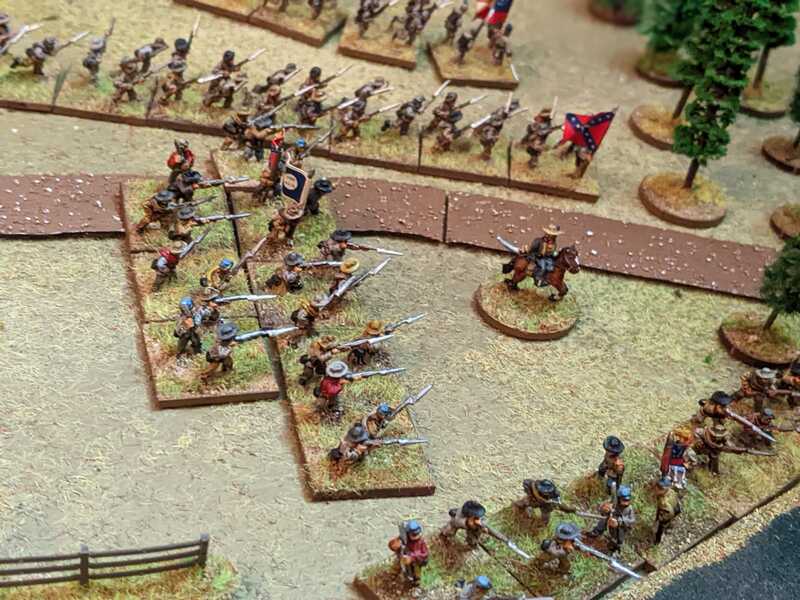


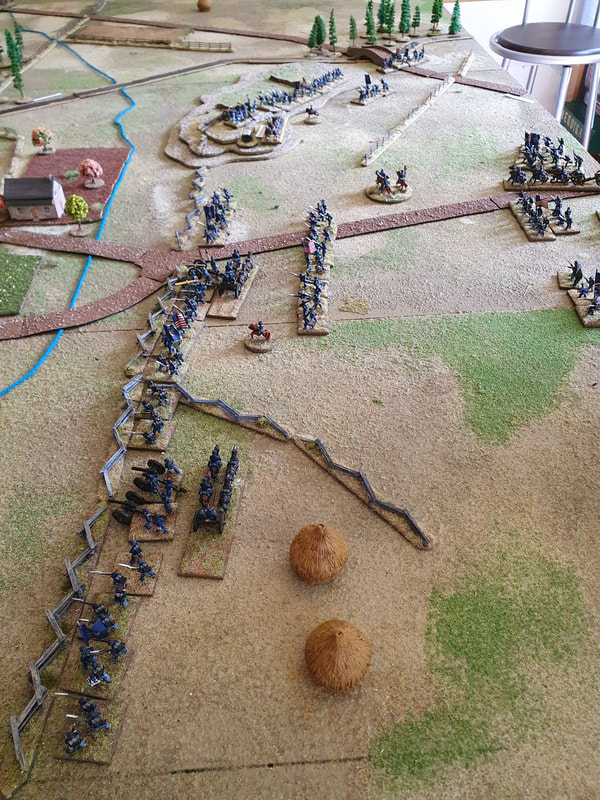
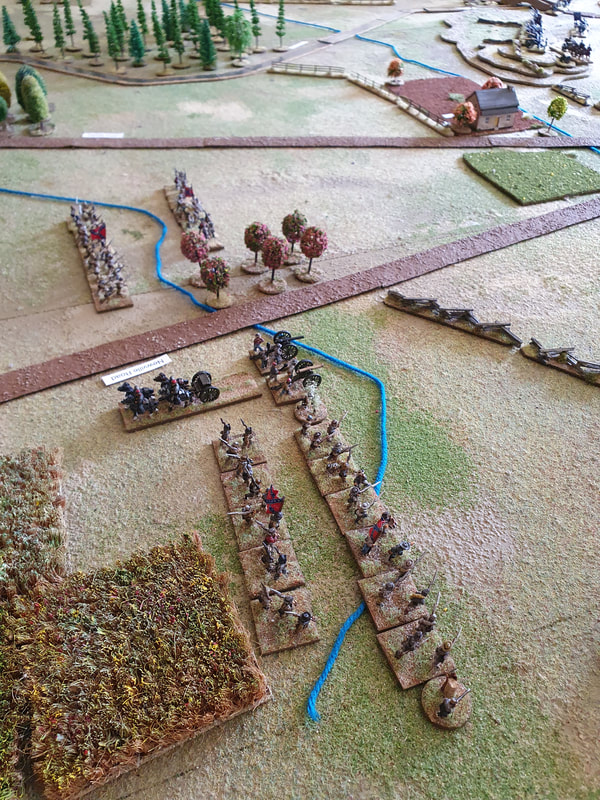

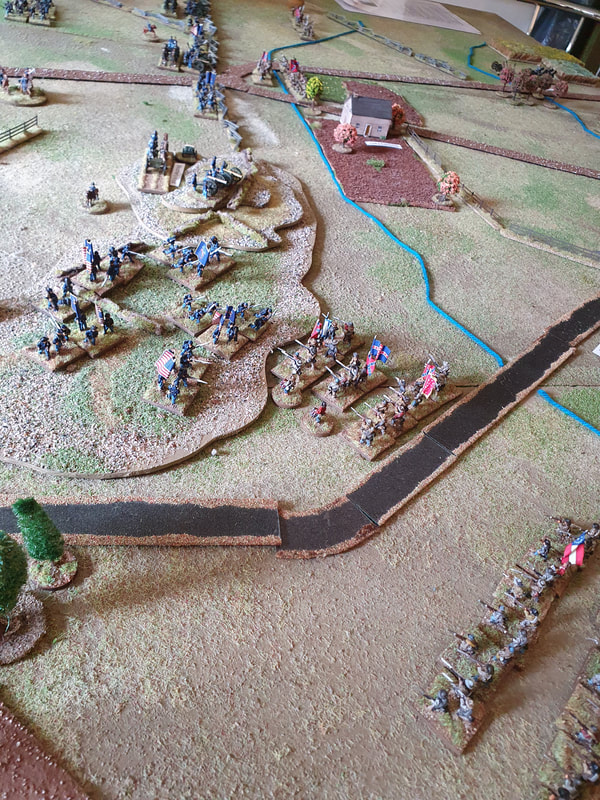
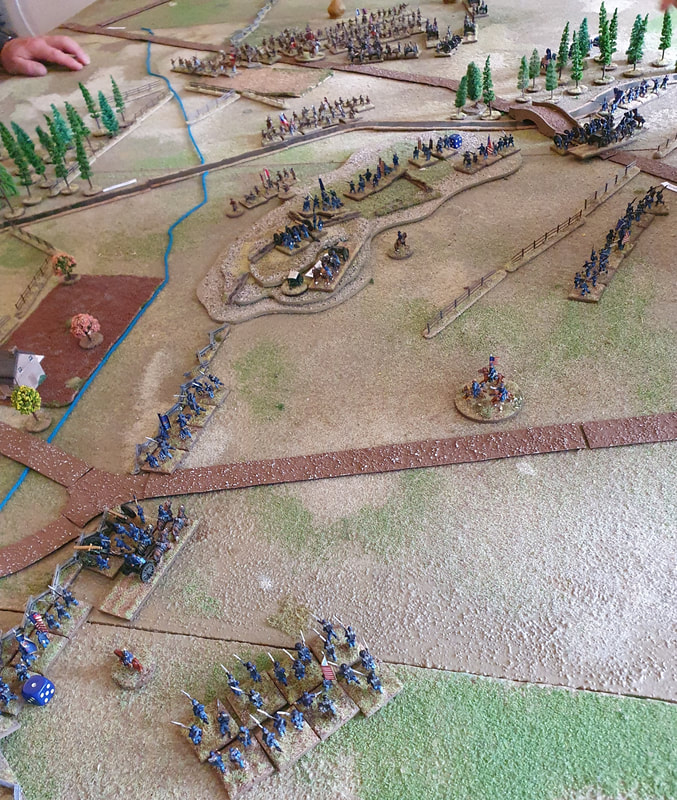
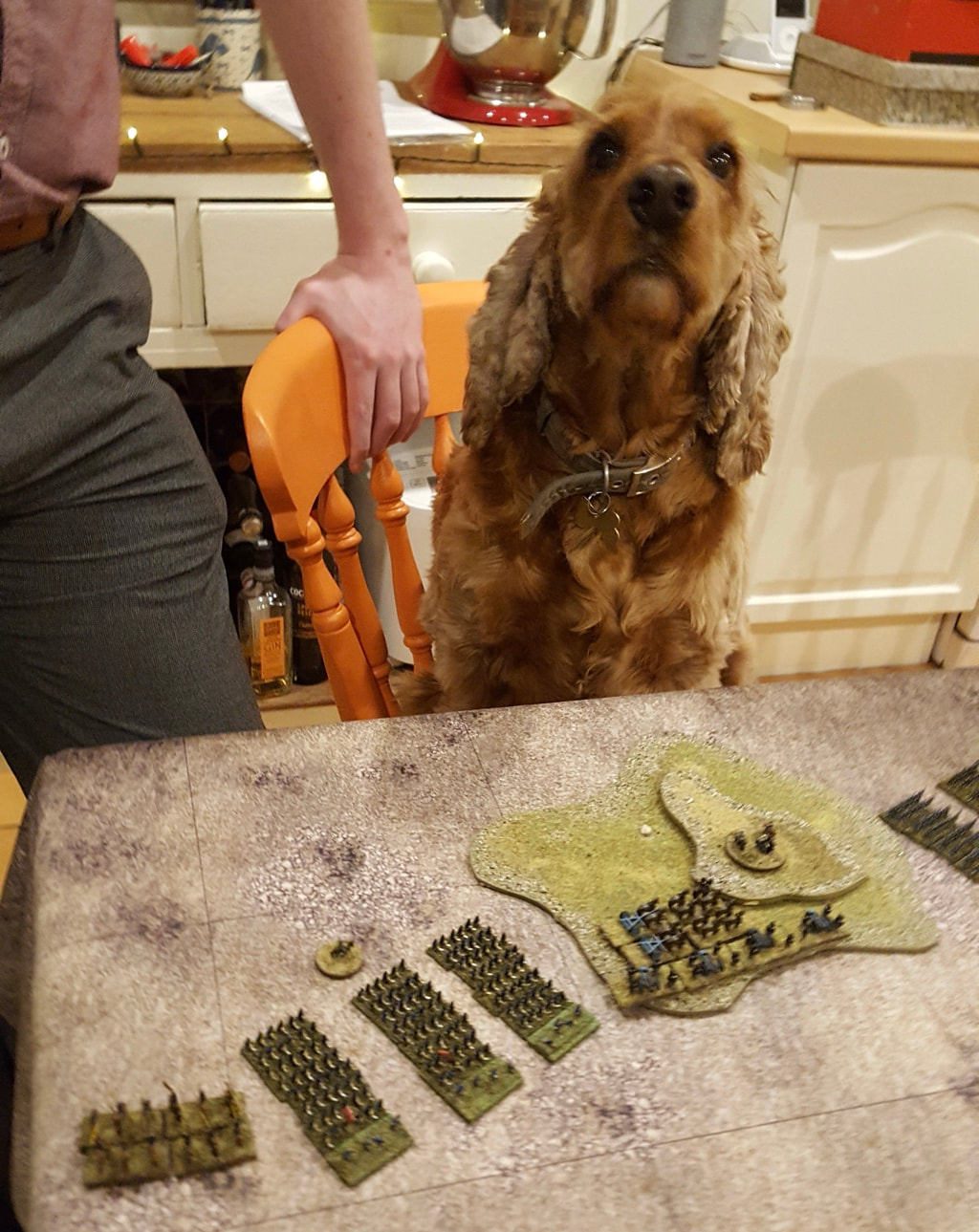


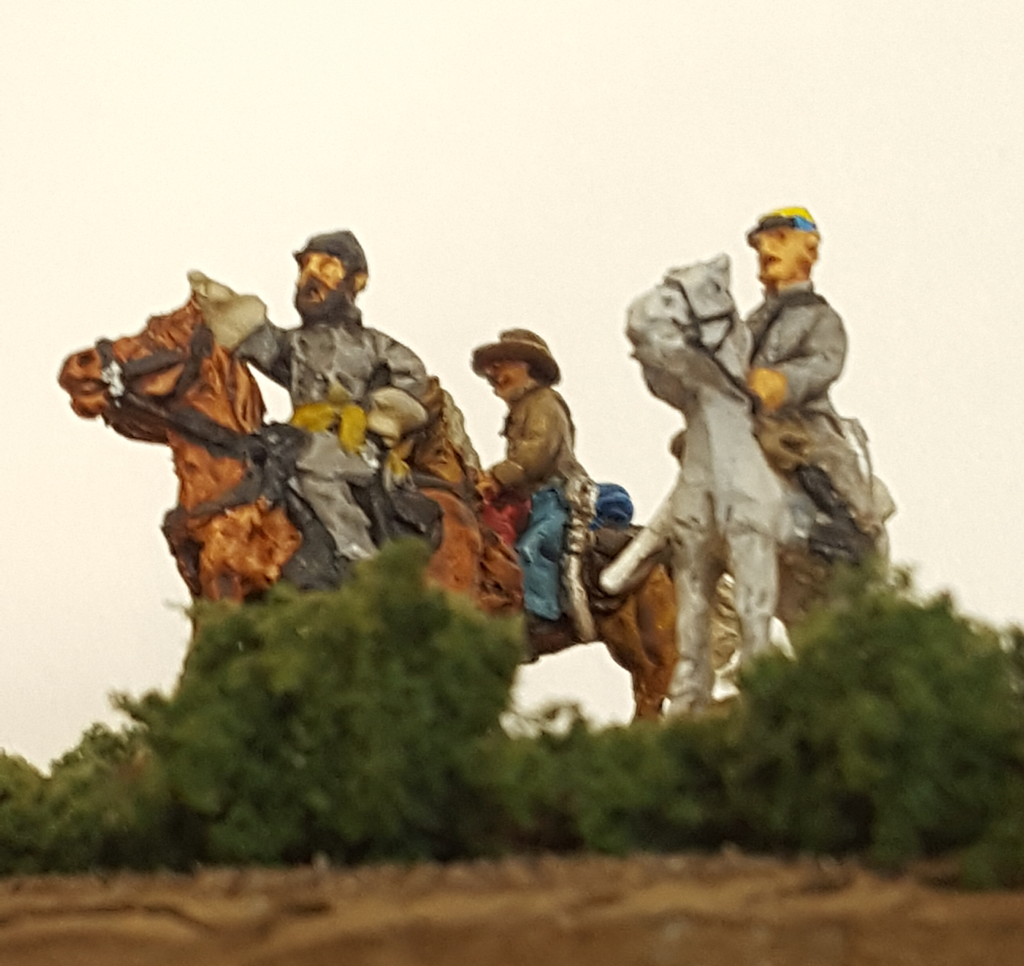

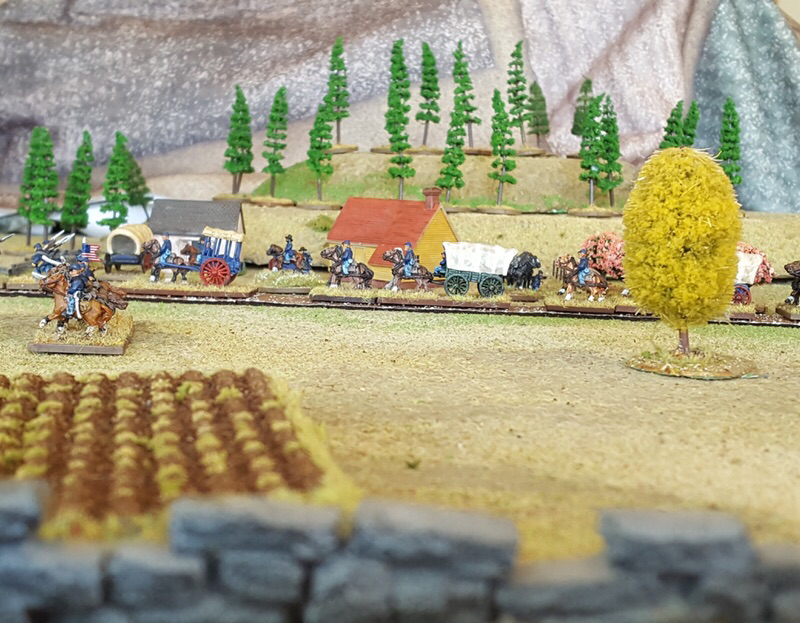




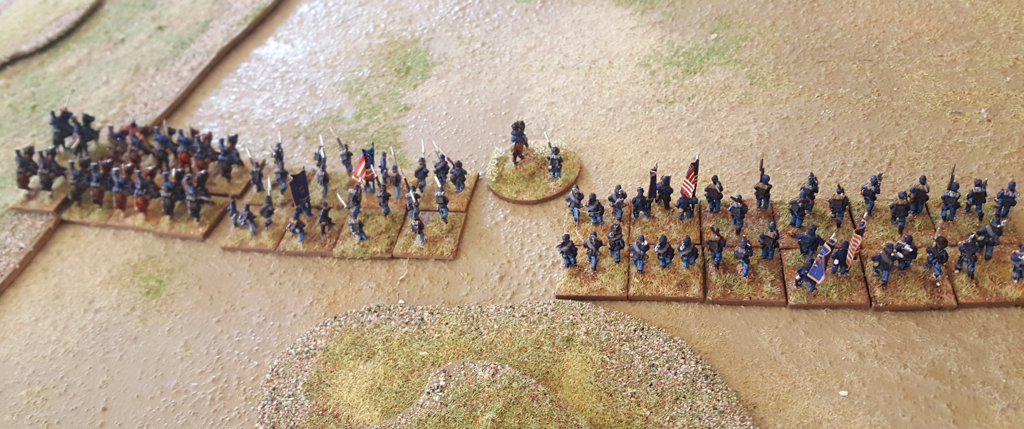


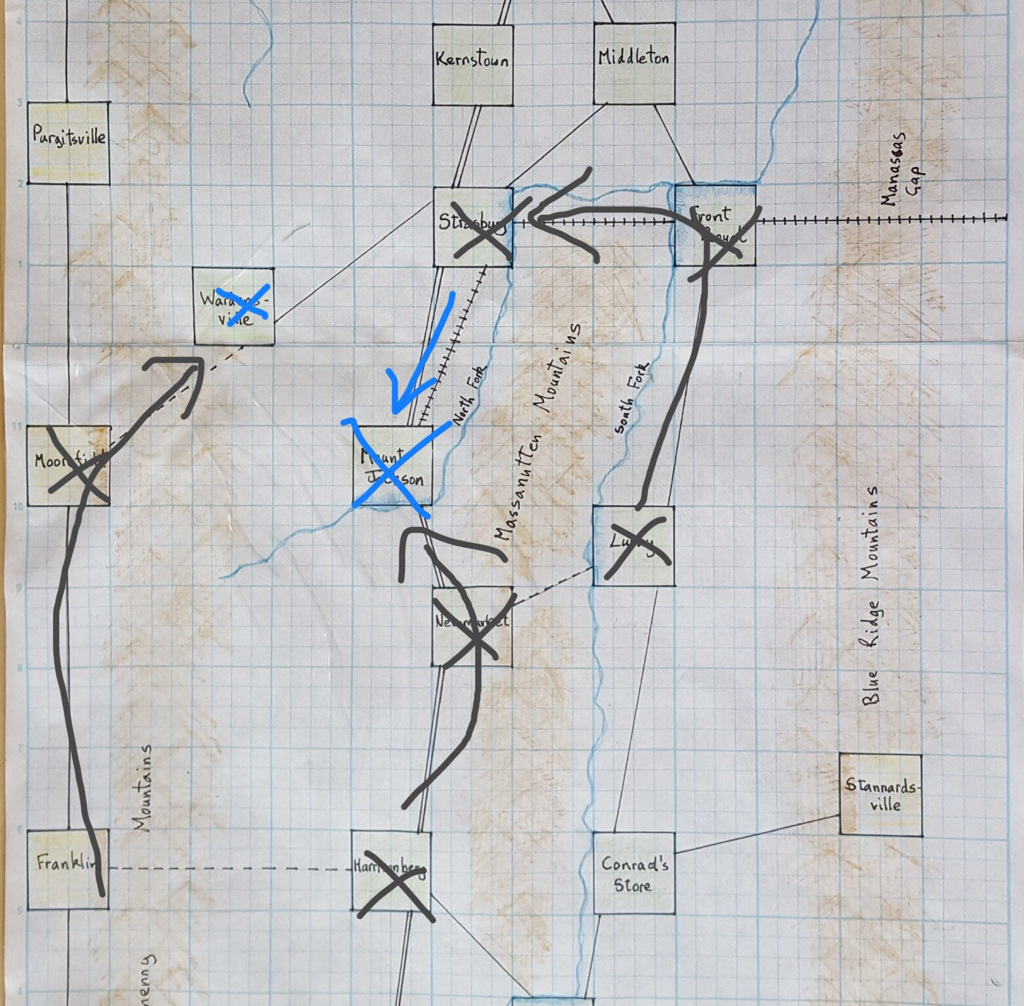
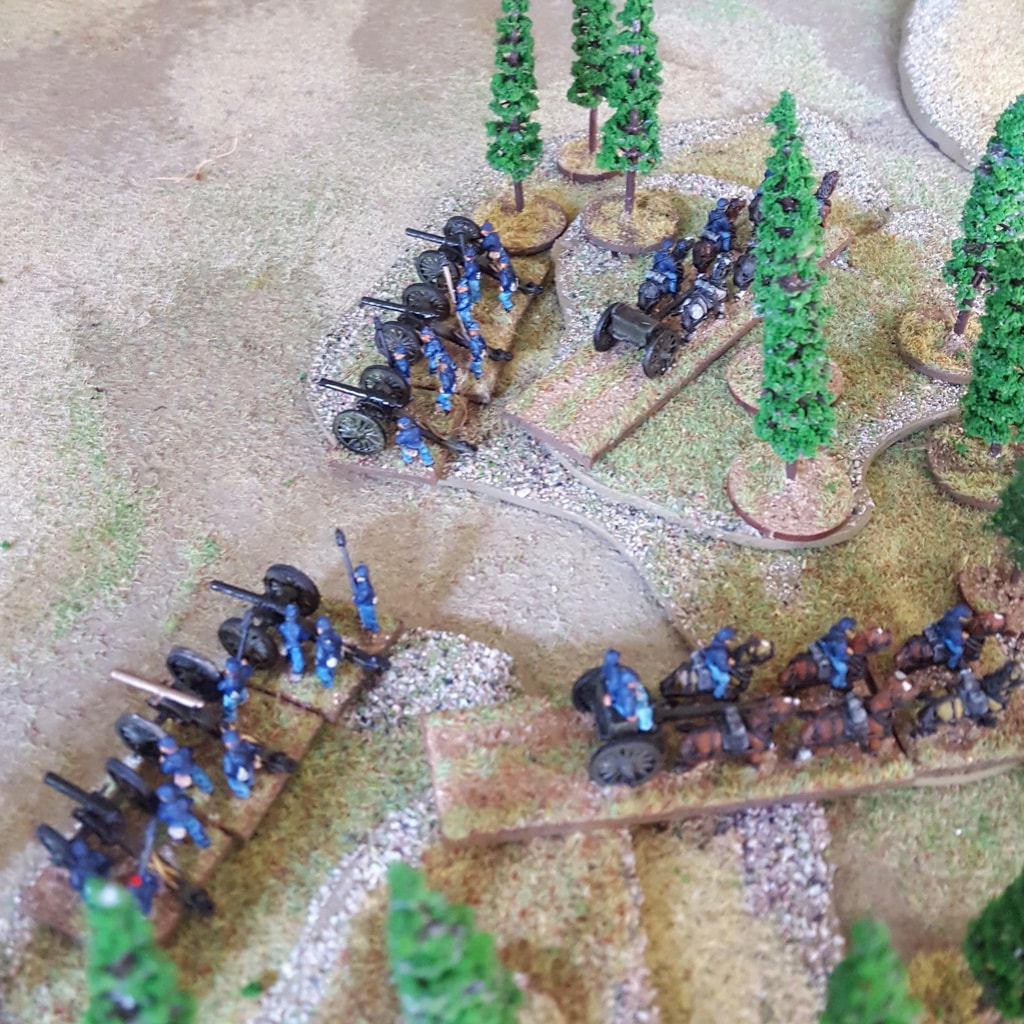
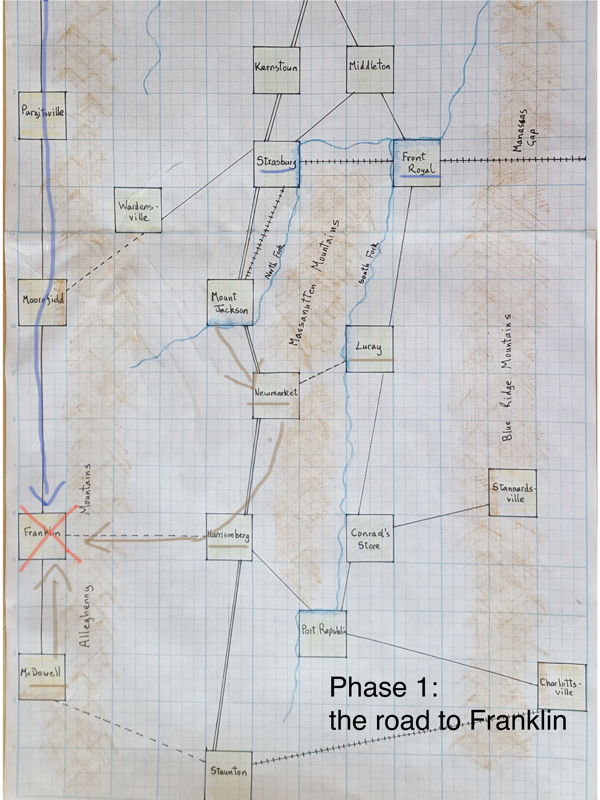
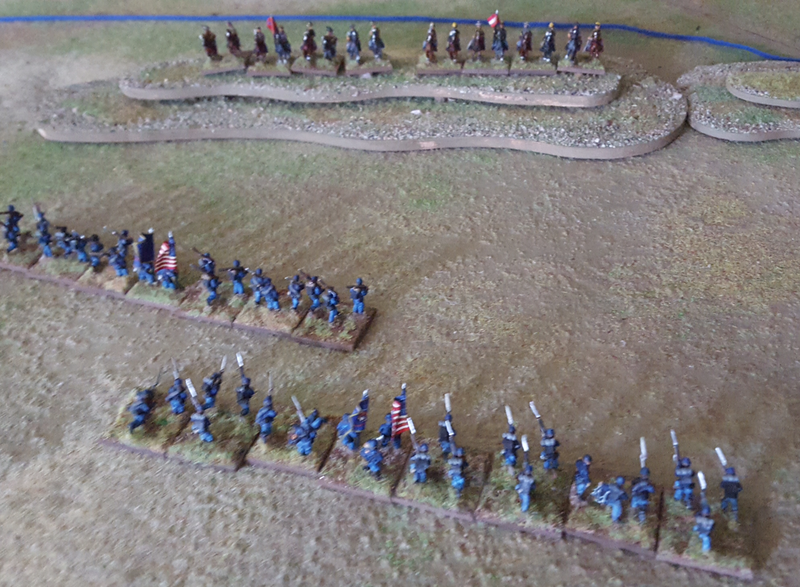
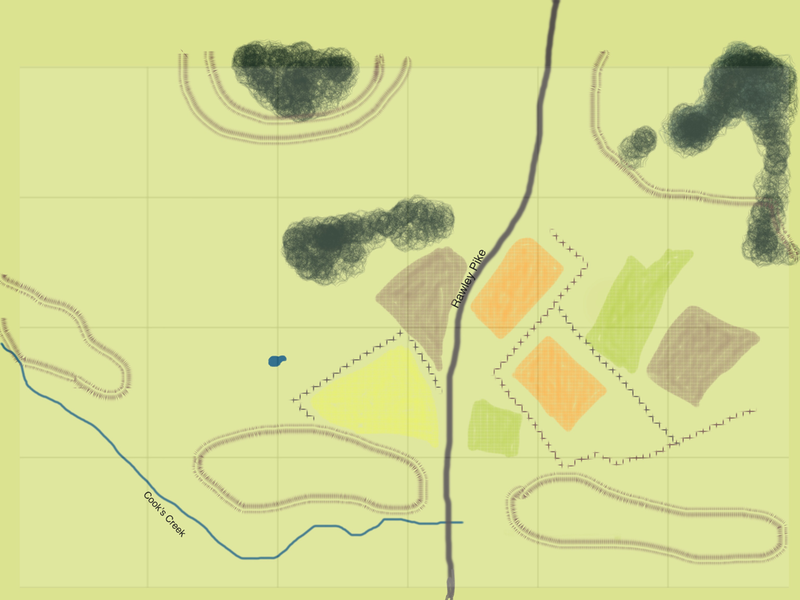

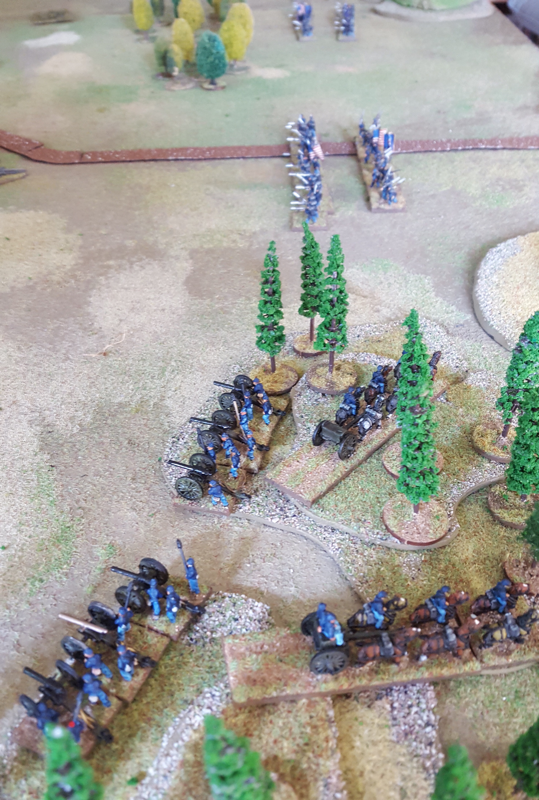


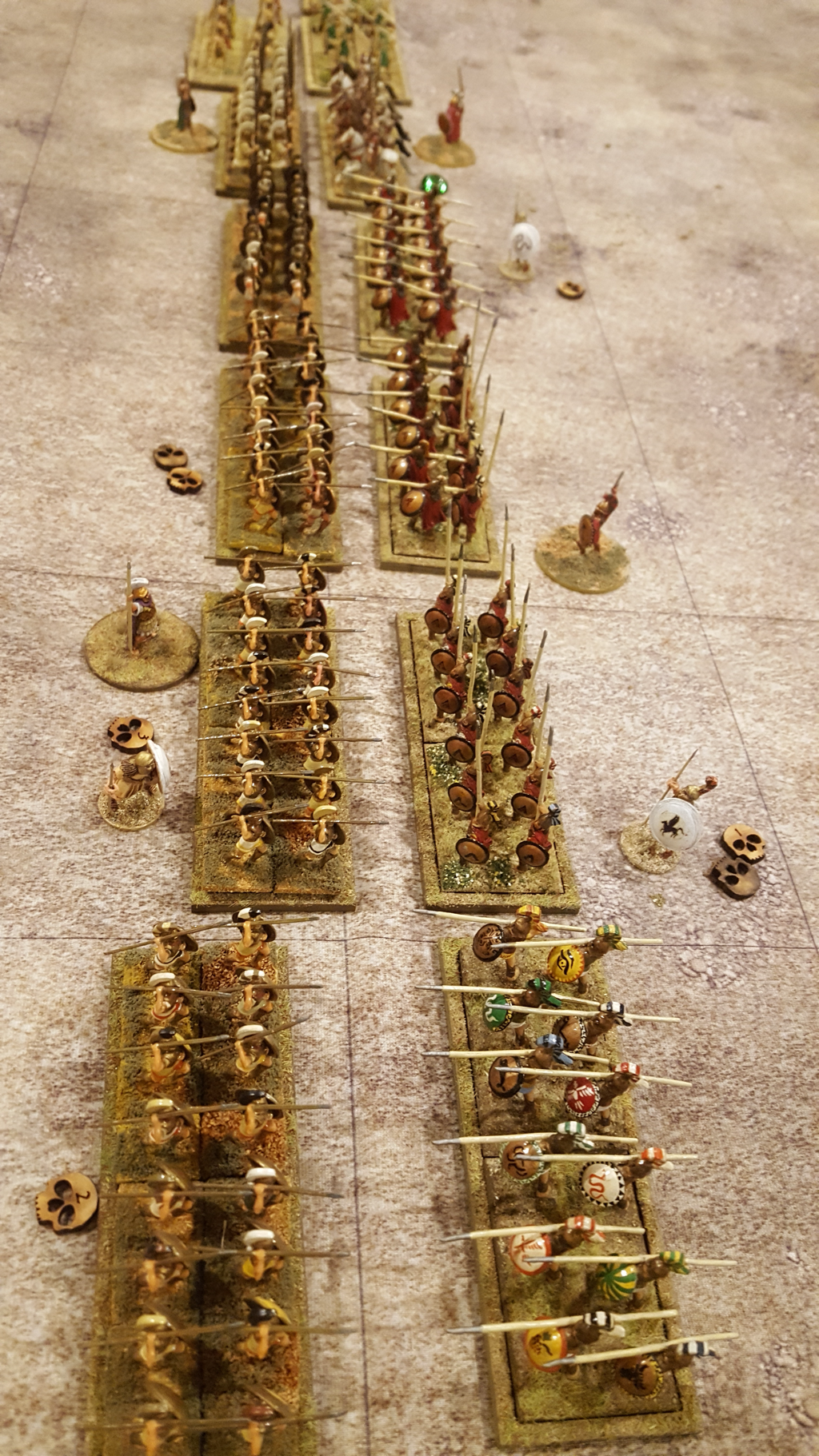

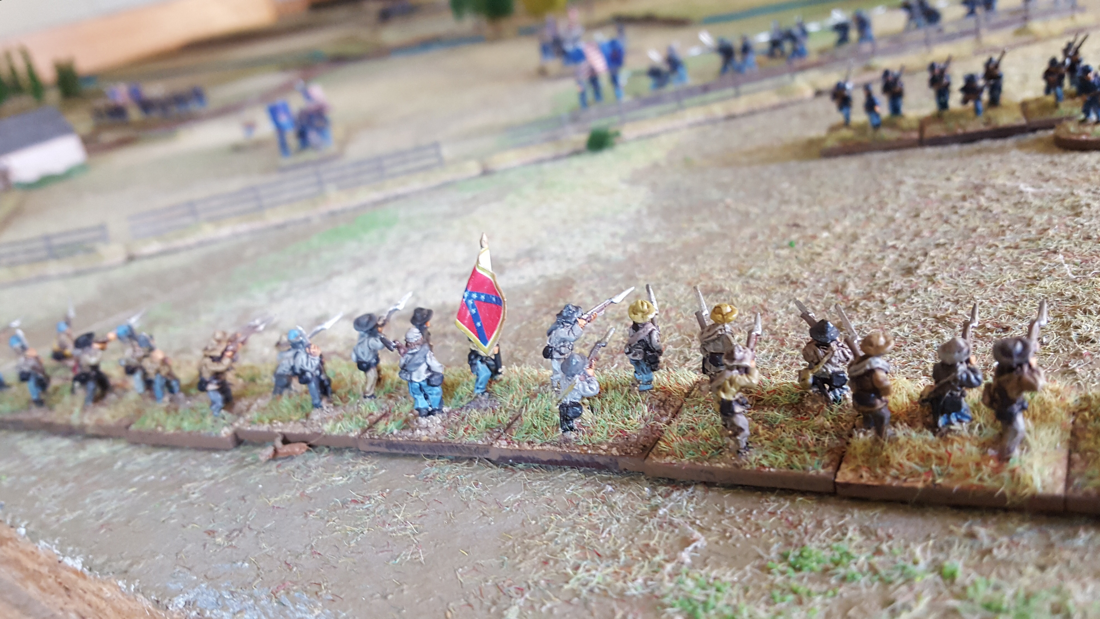



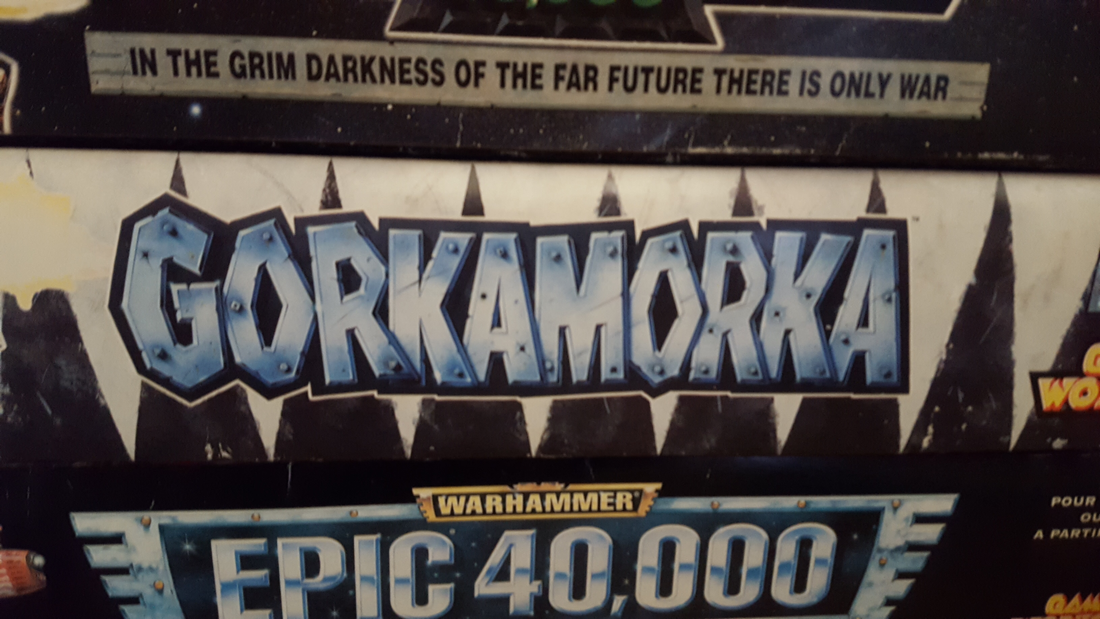




 RSS Feed
RSS Feed